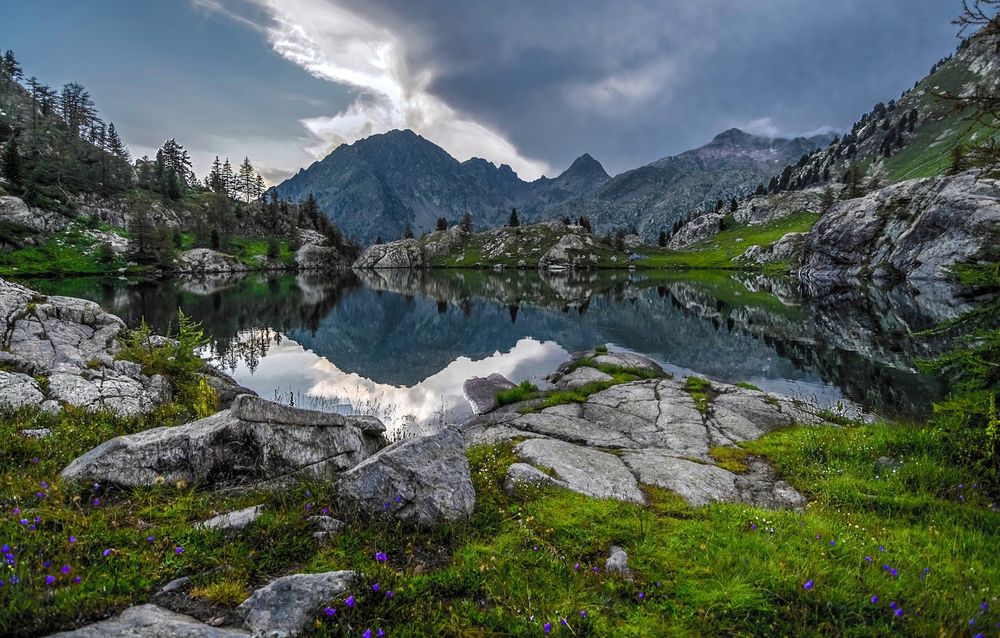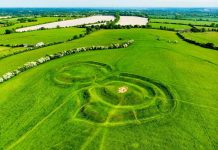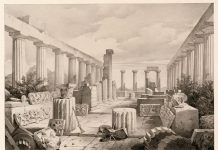Provence is one of the most beautiful regions of France. Lying in the south east of France, it takes in the Vaucluse, Bouches-du-Rhone, Var, Alpes-de-Hautes-Provence and the Alpes-Maritimes. From the snow-capped mountains of the Alps and the splendors of the Verdon gorge to lavender fields, the sparkling blue Mediterranean sea and Roman towns such as Nimes, it has everything the visitor could want. It was difficult to pick out the ten top sites, but here is my list of favorites.
The Palais des Papes (Pope’s Palace) in Avignon
The Palace of the Popes in Avignon stands high above the town, a wonderful mass of towers and huge high walls colored a deep orange in the Mediterranean sun. Avignon was once the heart of Christendom, elevated to top position by Pope Clement V who moved the Papacy here in 1309 at the invitation of the French King. As much a political move by the French monarch to extend his power over the church as a safeguarding of the Popes from a pretty dodgy time in Italy, the move made Avignon the most important city of Europe for nearly a century.
It took just 20 years, from 1335 to 1355, to build a palace grand and large enough for the Popes who brought all their servants, secretaries and papal business with them.
Pope Clement was succeeded by John XXII (ofUmberto Eco’sName of the Rose), then Benedict XII who built the Old Palace, and Clement VI who added the New Palace in the extraordinary Gothic style, giving the building its distinctive outline stone walls.
Among the highlights in the Palace don’t miss St. John’s and St. Martin’s Chapels with their 14th-century frescoes; the Pope’s chamber in theTour des Angesdecorated with intricate foliage and birds; the Stag Room of Clement VI with huge hunting and fishing frescoes, and the Great Audience Hall where the grandly named Court of Apostolic Causes met to pass judgement, against which there was no appeal.
A medieval wall still surrounds central Avignon and today it’s a delightful city to stroll around, with old streets and houses that take you from the Middle Ages through the elegant 17th and 18th-century residences.
The vineyards of Chateauneuf-du-Pape
Châteauneuf-du-Pape is a medieval village where the Château des Papes, built in 1317, looks out over the rolling hillsides and lavender fields. The château was the summer home of the Avignon popes and it’s a pretty place. But the villages main claim to fame is the wine of the same name.
And you get to taste the wine at the end of the tour.
If you’re here on the first weekend in August, you can watch the medieval knights doing all those gallant things medieval knights do, look at the parades, the horse contests, dance and of course taste at the different stalls.
The Camargue with its cowboys, black bulls, flamingos and white horses
The Camargue in the mouth of the mighty Rhone river is French cowboy country. On an island where the river divides, the remote area is home to these guardians who herd the black bulls and ride the white horses that characterize the salt marshes. For the nature lover, there’s an extraordinary variety of wild birds including pink flamingos.
Horeback riders wanting to take to the marshes should consider an accompanied ride. Check out the relevant companies on the website ofSaintes-Maries-de-la-Mer.
The Roman City of Nimes
Nimes, which lies on the border between Provence and Languedoc-Roussillon, is a Roman city with some impressive remains. Start at the wonderfully preservedLes Arenes, the first-century Roman arena. Two storeys of tiered seats housed the crowds of up to 20,000 who came to watch the gladiators fight and the charioteers race their teams around the vast enclosed arena. Today it’s the place for bull fighting and for Roman games which take place on a May weekend.
The other must-see sight is theMaison Carrée, a temple built in the 5th century and subsequently used by Napoleon as a model for theMadeleinechurch in Paris.
For modernists, Nimes has some famous recent buildings like the glass,concrete and steel Carrée d’Art designed by British architect Norman Foster.
As a curious aside, Nimes invented denim (thefabric de Nimeswas produced in the city’s textile mills and exported to the southern states of the U.S.A. in the 19th century to make clothes for slaves.
The Abbaye de Senanque
The 11th-century Cistercian Abbaye de Senanque is one of the iconic images of Provence. Surrounded by deep colored lavender fields, its strong Romanesque architecture radiates peace and tranquility, encapsulating the original aim ofBernard of Clairvauxwho founded the Cistercians as a simple, pure order in the 12th century.
Like all monasteries, its fortunes waned from its high point in the 13th century and it was torched, struck with plague and attacked by the French Revolutionaries.
Rescued by a private foundation of friends, it now has 5 monks living here permanently and has become one of the most visited abbeys in the south of France.
You can walk through the cloisters, its columns carved with fruit and vines, making a welcome cool respite in the heat of the summer and look at the tomb of the 13th-century Lord of Venasque in the nave. Other buildings include the calefactory which was was the only heated room where monks could read and write, the vaulted dormitory, and the chapterhouse lined with stone seats so the monks could sit to listen to the readings of the abbot.
L’Isle-sur-la-Sorgue
If you’re antique shopping, this is the village to come to. It’s near Avignon so is easily accessible if you’re in the area. More than 300 outlets sell antiques, china, glass, furniture, paintings and just about anything you can imagine.
It’s a chic town which owes its wealth originally to the watermills that pressed grain and oil. Today many of the shops are housed in the old mills and factory buildings and on Sunday there’s also a brocante fair along the river’s edge, where the goods are more bric-a-brac than antiques, and cheaper as a result.
In addition there are huge international antiques fairs at Easter and in the autumn.
The Perched Village of Gordes
‘Perched villages’ are one of the endearing sights in Provence. Located high up on rocky crags, they look out over the surrounding countryside. Originally built around the local medieval castle, the villages once defended a valley or hill from the enemy. They have defensive walls, and often just one gateway as the entrance. Steep narrow streets, often with arcaded passageways, wind through the villages, passing the all important public fountain and the small church.
You’ll come across them all over Provence, many with beautiful, smart and expensive hotels offering accommodation. Once inhabited by poor peasants, today you’re more likely to find the streets and bars full of fashionable French who’ve converted the previously insanitary hovels into chic second homes.
One of my favorites is Gordes, 38 kilometers east of Avignon in the Luberon, and near the Abbaye de Senanque. The village rises in terraces, its cobbled streets full of tall houses leading up to the castle, rebuilt in 1525 and now the town hall and museum. Like much of this part of the south of France, it attracted artists and the likes ofMarc Chagall,Victor Vasarelyand Pol Mara all spent time here.
The Gorges du Verdon
The drive up to the Verdon gorge is spectacular, particularly if you take the D71 from Comps-sur-Artuby through the blasted heath that is the huge military terrain of the Camp de Canjuers. You arrive at the Balcons de la Mescla and look down some 250 meters to the 25-kilometer-long (15 mile) Verdon gorge that contains the river. The road snakes like a serpant above the river until you reach the huge Lac de Sainte Croix, made by damming the river near Ste-Croix village.
You can take a whole day driving the 140 kilometers (85 miles) around the Verdon gorge. To the north the Route des Cretes is a challenge – a road that gives you steep views down into the gorges and some hair-raising moments as the road goes scarily close to the edge.
Charming villages line the banks: Aiguines has a 17th-century chateau and Moustiers-Sainte-Marie to the north of the Gorges is picture-postcard pretty (it’s classified as one of theMost Beautiful Villages of France) and has good pottery to buy.
If you’re energetic, take the long GR4 walking trail through the canyon, with a smaller part known as the Martel Train taking you through the middle of it. There’s also rock climbing and whitewater rafting available. Ask at the local tourist offices.
Vaison-la-Romaine
With a Roman bridge, and remains like thePuymin, an important district in Roman times, an intact medievalhaute ville(upper town) and a ruined clifftop castle built in 1160 by the Count of Toulouse, Vaison-la-Romaine is an attractive place. It started life as a flourishing Roman town, then over the centuries was buried by sand from the river. Rebuilt in the Middle Ages, the Roman remains were only discovered by archaeologists in 1907.
The old quarter of the upper town to the south of the river has delightful 17th-century town houses and fountains protected by stone ramparts and a massive 14th-century gateway. It’s linked to the Roman residential districts by the Pont Romain that takes you to the north part of the river. Here you’ll find theMaison des Messii, home of an important Roman family; the theater with 34 semi-circular rows of stone benches used today for the July festival, the House with the Dolphin and the impressive portico of Pompey.
The Mercantour National Park and the Vallee des Merveilles
TheParc National de Mercantouris a huge mountain park in the east near the Italian border. More dramatic and in many places bleaker than the Verdon gorge, this is one of France’s great wildlife habitats, with chamois, ibex, olden eagles and birds of prey, hoopoes, ptarmigan and many more species.
Get information, maps and the chance to book guided walks at the variousMaisons du Parc. You’ll find them inSt-Martin-Vesubie,St-Etienne-de-Tinee, and other local villages.
One of the most spectacular walks is in theVallée des Merveilles(the Valley of Marvels) which has some extraordinary rock engravings from the Bronze Age. It’s best to do a guided walk with experienced guides; if you want to do an overnight hike, you’ll be staying in the various refuges, carrying your own equipment and food.


























